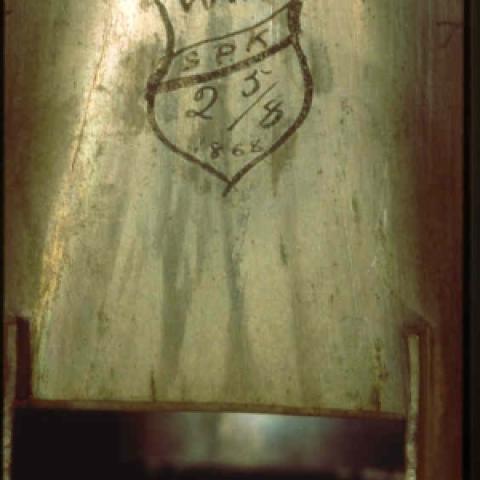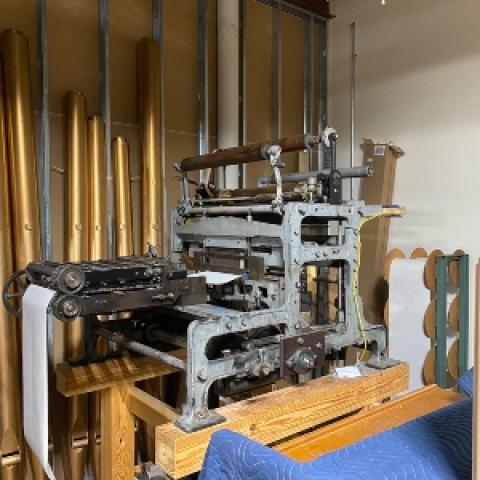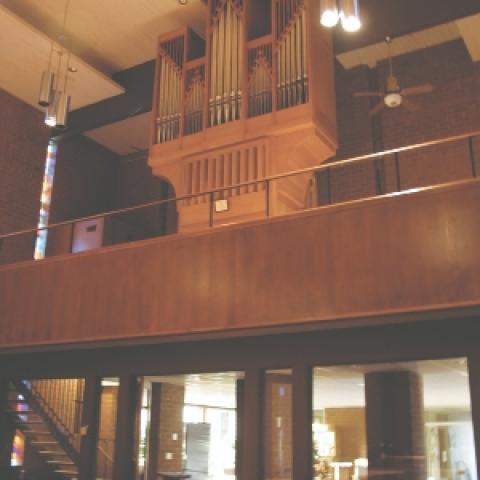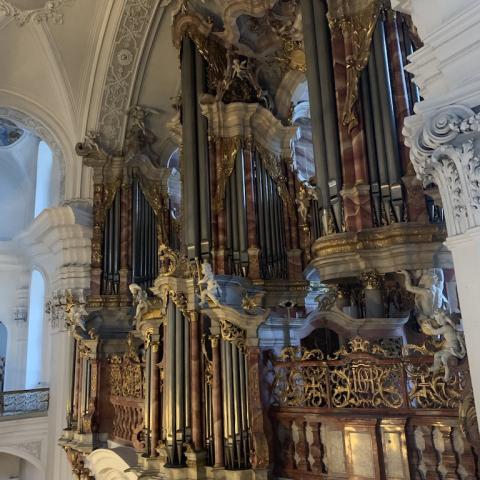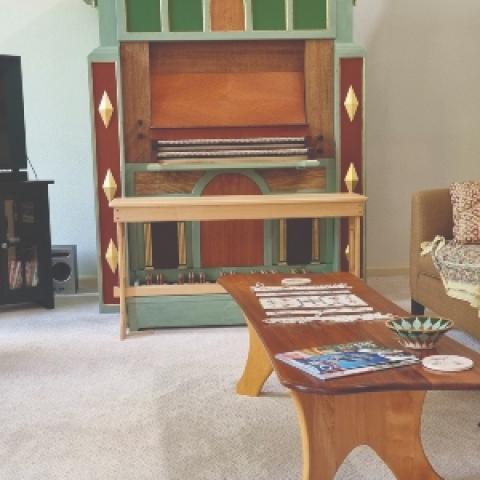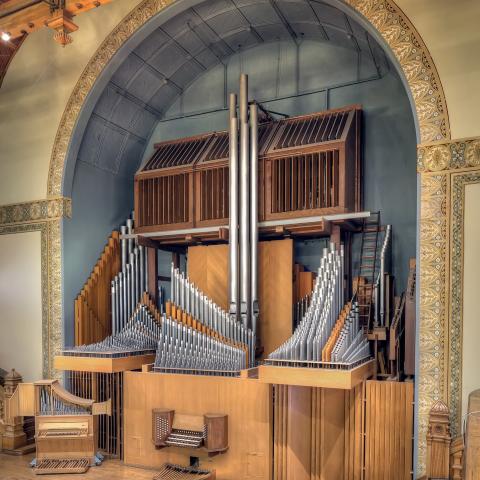
Preservation by relocation
News of churches closing crosses my desk ever more frequently and shows up as rants on social media forums at the same pace. I read comments claiming that a closing is “criminal” or “unconscionable” as if reasonable and caring people did not spend years discussing how to manage an albatross of a building with the tithes of fewer and fewer congregants. In the early 1990s, I renovated a large three-manual organ at the First Baptist Church of Arlington, Massachusetts, and continued to maintain it until a couple years ago. There were 150 pledging families at the time of the organ project. By the time I retired from maintaining organs, there were fewer than fifty families struggling to maintain the huge stone building with a 1,000-seat sanctuary and monogrammed china service for 1,200.
As we completed that project, I got to know Eleanor Metcalf, an elderly church member who played the organ, practiced at the church, and substituted occasionally for the regular organist. She had grown up in the Baptist church in nearby Watertown, Massachusetts, where she studied with the organist as a teenager and loved to sit in a particular pew where she had a view of the organ’s pedalboard. She was a lifelong fan of Bach’s Prelude and Fugue in D Major, BWV 532, which she said she could never play herself, but was thrilled to watch her teacher whip through those opening scales on the pedals. When she and her husband celebrated their fiftieth wedding anniversary, they engaged me to play a recital for their family and guests on the Watertown organ. Of course they sat in her favorite pew, and of course I played Bach’s D Major. A few years after that, the Watertown church closed, as the congregation had dwindled past sustainability. The building was subdivided into condominiums, and the organ, which was not of great distinction, was discarded.
Last week I received a call from a member of the Belmont-Watertown United Methodist Church, a congregation created ten years ago by the merging of the Belmont and Watertown churches, saying they were interested in selling one of their organs. (Belmont, Watertown, and Arlington, Massachusetts, are neighboring towns, about five miles west of Boston.) I had maintained the organ in the Belmont church for years, and as it too lacked distinction, I was glad to hear that they wished to sell the exceptional organ in the Watertown church.
As it happened, I was planning to drive between our homes in western Massachusetts and coastal Maine the next day so it would not be far out of my way to make a quick visit to Watertown. Wendy sealed the deal by reminding me that there is a spectacular Middle Eastern grocery store in Watertown. The congregant, Laurel, told me the story of their decision process that led to the merging of the congregations ten years ago. The Watertown church has a long history of outreach that led to dozens of weekly meetings of self-help and social organizations like Alcoholics Anonymous, Mothers Against Drunk Driving, and the like. The merged congregations had been worshiping in the Belmont church, renting the Watertown sanctuary to a Korean congregation, and continuing the outreach programs in the Watertown building.
They have recently decided to sell the property in Belmont and the large stone parish house that adjoins the Watertown church building, which will be converted to condominiums, and redevelop the church to accommodate the merged Methodist congregation and all the outreach activities. The church building includes a large sanctuary, an adjoining fellowship hall, and a large basement with classrooms and open space. The chancel, which contains the organ in side chambers, will be separated from the nave to create an additional large meeting room, which explains the idea of selling the organ in the interest of its preservation.
. . . and what an organ
While the organs in the Belmont Methodist and Watertown Baptist churches were unremarkable, the Watertown Methodist church has a spectacular instrument, Skinner Organ Company Opus 459 (1924), with four manuals and thirty-four ranks. Skinner produced many organs of this scale based on a scheme of expression and flexibility. This organ has four enclosed divisions (Swell, Great, Solo, Echo), three sets of Celestes (Gamba, Salicional, Flauto Dolce), three 8′ Open Diapasons, nine reeds, a two-stop Echo division (Chimney Flute and Vox Humana with Chimes), and a Harp/Celesta. It is full of lavish extras like celestes that start at low C and sixteen-stage expression motors. A creative organist can do anything with an instrument like this. As I write in mid-June, the organ will appear on the website of the Organ Clearing House in the next few days. I wonder if it will still be available as you read this in early August.1
Laurel told me how the congregation loves that organ and respects its heritage, and though they are heartbroken at the thought of losing it, they know they would never be able to fund the necessary renovation. When I visited the other day, the organ had not been used for six years. When I started the blower, there were dozens of ciphers and only a few notes on a few stops that played. From that perspective, the organ seems like a wreck, but when I climbed around inside the two chambers I marveled at the “like new” condition. Scrolls on reed pipes were neat and tight, everything was standing straight, and there was none of the tuner’s detritus we often see laying on perch boards or in corners. I imagine that in the ninety-eight years since the organ was built, no inept service technician ever entered the organ chambers. I understand and respect the decisions made by the board of trustees of the merged congregation, and I am confident that another congregation will acquire and restore the marvelous organ for another century of inspiring use.
Another transplant
In the June issue of this magazine, I wrote about visiting the Organ Clearing House installation of an organ by Gabriel Kney at Saint Meinrad School of Theology in Saint Meinrad, Indiana.2 That organ became available when the church that commissioned it in 1980 decided to divest itself of real estate and use the proceeds of the sale to create a fund forming the core of a church devoted entirely to public service. Once again, the decision was the result of years of reflection and discussion as they realized that it did not make sense for the ever-smaller congregation to try to sustain a complex physical plant. The people of that church were thoughtful, creative, and eager to continue serving the community as effectively as their resources would allow, and they are pleased to know that their organ is now being used daily in the chapel of a flourishing seminary.
From Passaic to Ingelheim
Around the year 2000, the First Presbyterian Church in Passaic, New Jersey, was experiencing decline in membership and was saddled with a large complex building it could no longer afford to maintain or operate, and it entered into an agreement with a neighboring growing congregation to swap buildings. I do not remember the details of the deal, but I know that the result was that each congregation wound up in a building of appropriate size. The swap was completed with the understanding that the Presbyterian church’s Skinner organ (Opus 823, 1930) remained their property, and that the organ could be removed when it was sold.3 In 2008 we organized the sale of the organ to the Evangelische Saalkirche in Ingelheim am Rhein, Germany.
The organist of the Saalkirche, Carsten Lenz, was enamored by Skinner organs and had long dreamed of importing one to Germany. He first visited me at the Organ Clearing House exhibition booth during the 2002 convention of the American Guild of Organists in Philadelphia. Later, we met in New York City and New Haven, Connecticut, to visit Skinner organs. It took several years for his church to raise the funds and negotiate the sale, but in 2008 we dismantled the instrument and shipped it to Klais Orgelbau, who renovated the organ and installed it in Ingelheim.
This was another example of the “smallish” four-manual organs by the Skinner Organ Company with thirty-nine ranks and thirty-six stops including four 8′ Open Diapasons, four celestes (Gamba, Salicional, Echo Viole, Dulciana), eleven reeds, three expression boxes, and a Harp/Celesta. Sorry, no two-stop Echo. Like the Watertown organ, this scheme developed by Mr. Skinner defines an exceptionally versatile and expressive instrument. I was excited to visit the organ in Ingelheim in 2019 and pleased that while Klais had made some modifications to the instrument, the Skinner organ was otherwise intact and recognizable in its new home. Carsten gave me an energetic demonstration and tour and told me that German organists have responded to it enthusiastically.
Worthy of preservation
I have mentioned two organs that I deemed unworthy of preservation. Both were useful, serviceable instruments that enhanced worship and brought pleasure to listeners. Remember Eleanor Metcalf worshiping in Watertown as a teenager in the 1930s in the thrall of that organ. You might think there must be some place for it. But the fact is, there are hundreds of organs available at any given time, and it is a good year when we place more than twenty. If I can offer a masterpiece like the Skinner in Watertown, it is hard to justify encouraging a church to spend hundreds of thousands of dollars on an ordinary or even mediocre instrument. View it through a wider lens. There is a finite amount of money spent on pipe organs in the United States each year. Isn’t it our responsibility to see that most of it is spent on excellence?
There is an exception to this idea. The church that owns and loves a reliable, useful organ, one that might not merit the cost of preservation through relocation, should be encouraged to keep it in good condition, even if it needs an expensive renovation like releathering. I am not thinking of a wreck of a pipe organ that has been “improved” by unqualified technicians. Eleanor’s church in Watertown maintained their organ well until they realized that the entire campus was beyond their means.
Former glories
I mentioned 1,200 sets of monogrammed china to provoke the image of a parish hall set up for a huge dinner, backed up by a professional kitchen that could produce that volume of food, tuna casserole being the 1950s equivalent of loaves and fishes. There are photos of just such an event hanging in the parish hall of that church, the men wearing identical skinny ties and white shirts under their jackets and the women with updos. In the age of TV dinners and cars with tailfins, suburban Protestant churches around Boston were packed on Sundays, home to softball and bowling leagues, and the huge buildings they left to their descendants have become impossibly expensive to maintain.
Over twenty years with the Organ Clearing House, I have spent hundreds of hours in church buildings that have been closed. I have heard about how much a church meant to lifelong parishioners. They have shown me photos of their children’s baptisms and weddings and parents’ funerals, and now they are reduced to clearing decades of churchy stuff out of a building. What do you do with 500 pew Bibles, fifty choir robes, a hundred bottles of Elmer’s glue, or a library of choral music? In at least one church, the last-standing loyal parishioners were members of the “Disbursement Committee.” Without exception, these people are heartened to know that their organ will have new life, metaphorically carrying the life’s breath of their church to worship somewhere else. While it is always sad to see a church building breathing its last, it is a privilege to be able to preserve a good organ.
Some years ago, I visited a church building in New Jersey that had been purchased by a new congregation. It was a large, elegant structure in a prominent downtown location with hardwood paneling on the front of the wrap-around balcony and a big Austin organ down front. The original congregation had abandoned the building without any planning. It was during the last service that the people were informed that it was the last service. They simply closed the doors and put the building up for sale. The bulletins were in a dusty heap at the ushers’ station, the water glasses were on the pulpit, the altar flowers were long rotted, and that Sunday’s anthem was heaped on the choir room piano. It was the only church I have visited that was closed without years of careful, thoughtful planning. There must have been some angry people after church that day. I wonder if there was a coffee hour.
It is more usual for a closure to happen after years of deliberation. If two congregations are merging, which building is retained? There are likely to be conflicting sentimentalities competing with practicality. One building might be better suited for redevelopment for another purpose. It can be tricky to build condominium residences in a Gothic building. What do you do with thirty-foot stained-glass windows? In some cases, one building is chosen, but the better organ from the other building is moved. Each individual case is a sad story. Each involves personal and community loss. But this trend is undeniable, inevitable, and in most cases, unavoidable. It is not useful to rattle along on social media about criminal negligence, irresponsibility, or thoughtlessness. It just is.
I am impressed by the story I have learned about the churches in Belmont and Watertown. I think they are being creative with their heritage and their resources. I am sorry that the wonderful Skinner organ will have to leave town, but I know it is worthy of proper restoration, and I expect it will be easy to find it a new home.
Good old Mr. Skinner
When I was a student at Oberlin in the 1970s, we were all in the thrall of modern tracker organs built on classical models. I did not understand or appreciate Mr. Skinner’s ideals; in fact I admit I was disdainful of them. Of course, the trumpet and mixture should be on the Great. What sense does it make to bury them in the Swell? Wait. I get it. More of the “meat” of the organ is under expression. Couple the Swell to the Great and start the verse with the box closed. It is a great effect to put the wind at the back of the processing choir by opening the box slowly.
The Ernest M. Skinner Company built its first four-manual organ for Grace Church in New York City (now home of a smashing organ by Taylor & Boody) in 1902. The organ in Watertown, built in 1924, is the 103rd four-manual Skinner, most of which are modest in size with fewer than forty ranks. This scheme was a wonderful subset of Skinner’s prolific career with imaginative use of a relatively small number of voices combined with seemingly lavish excesses of construction.
I have listed some of the attributes of Opus 459. G. Donald Harrison joined the Skinner Organ Company in 1927, three years after the Watertown organ was installed. In 1936, the newly formed Aeolian-Skinner Organ Company installed the iconic organ at Church of the Advent in Boston (Opus 940),4 long recognized as a near perfect example of the American Classic organ with three fully developed principal choruses, a Positiv division, and several mutations. Under its two names, the company produced 481 organs between Watertown and Church of the Advent, a little over forty a year.
Ernest Skinner grew bitter in his old age as the style of organ he developed fell out of favor. Walter Holtkamp, Sr., rebuilt the Skinner organ at the Cleveland Museum of Art. While that project was underway, Holtkamp saw the elderly Ernest Skinner standing forlorn and alone at a function of the American Guild of Organists. He thought to himself, there is one of our greatest organ builders and no one wants to talk with him. He walked up to Skinner and introduced himself as Walter Holtkamp from Cleveland. Skinner, who was hard of hearing, snapped back, “Cleveland? One of my finest organs is in the art museum there, and some damn fool is trying to change it.”
Notes
1. pipeorgandatabase.org/organ/22899.
2. organclearinghouse.com/sold#/3085-gabriel-kney-dallas-tx.

